人教版 七年级上 Unit 4 Where's my schoolbag? Section A 1a-2d 课件 (共50张PPT)
文档属性
| 名称 | 人教版 七年级上 Unit 4 Where's my schoolbag? Section A 1a-2d 课件 (共50张PPT) | 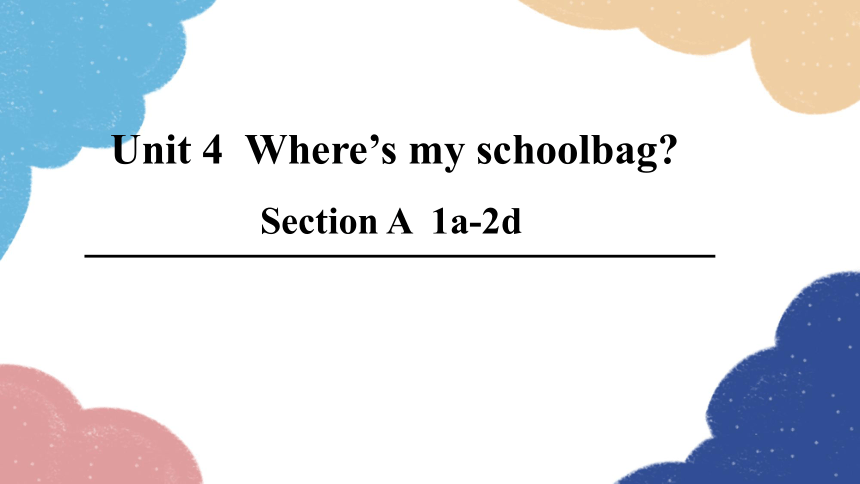 | |
| 格式 | pptx | ||
| 文件大小 | 9.3MB | ||
| 资源类型 | 教案 | ||
| 版本资源 | 人教新目标(Go for it)版 | ||
| 科目 | 英语 | ||
| 更新时间 | 2022-07-18 22:52:56 | ||
图片预览

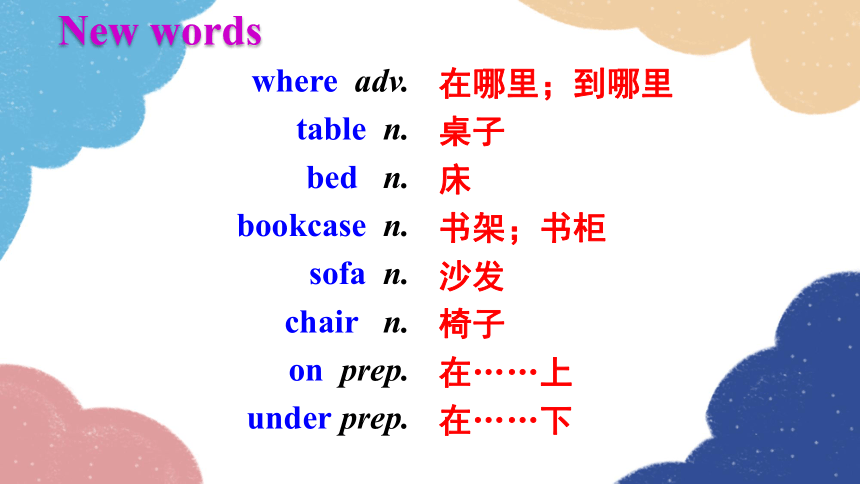
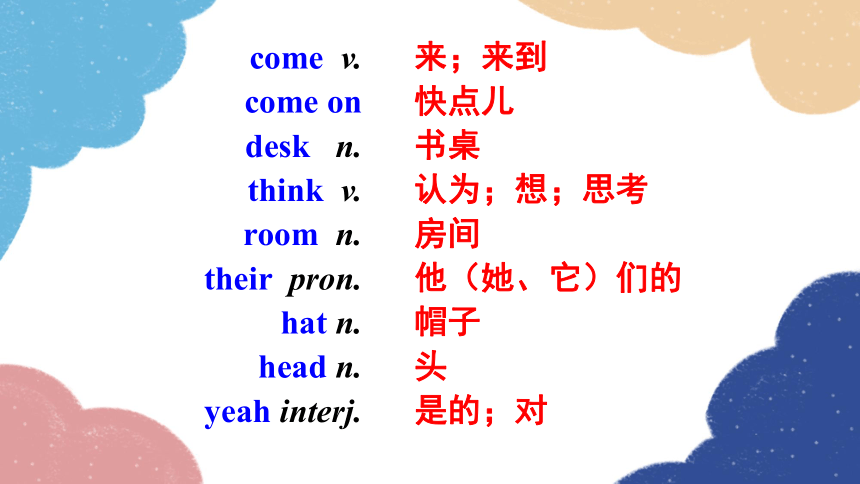
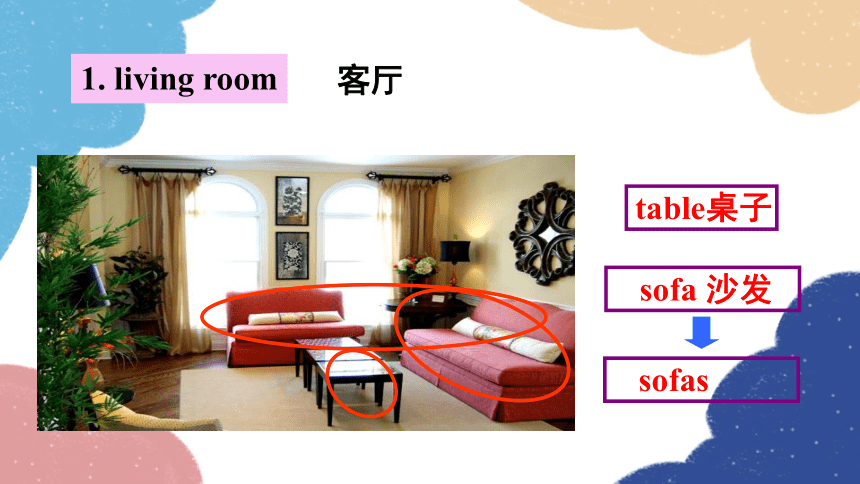
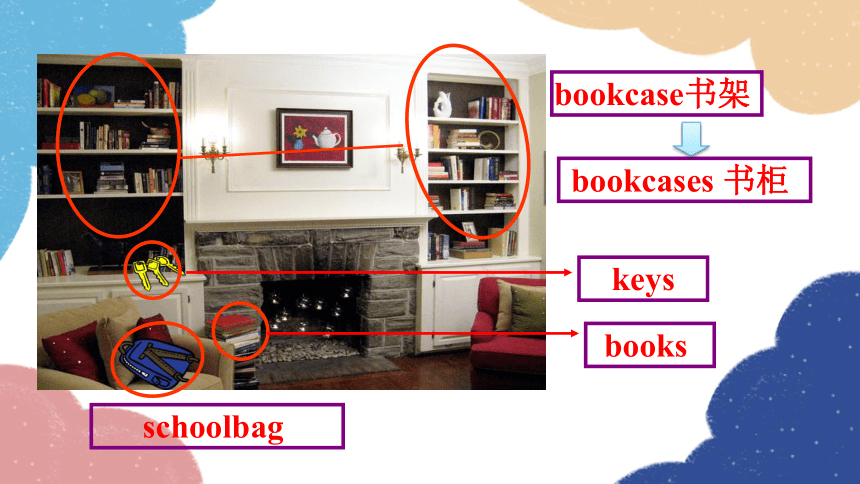



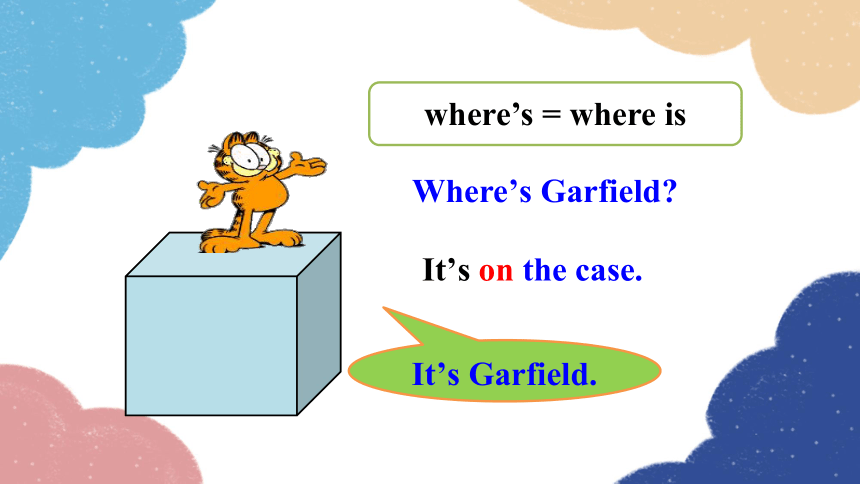


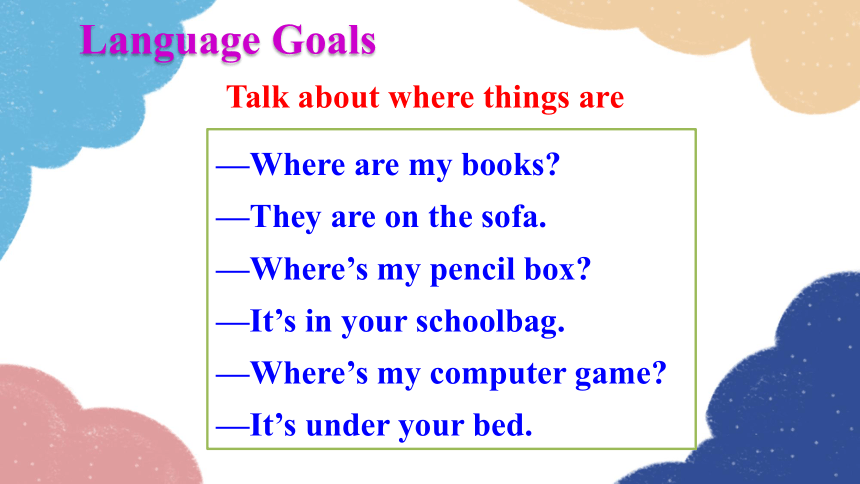
文档简介
(共50张PPT)
Unit 4 Where’s my schoolbag
Section A 1a-2d
New words
where adv.
table n.
bed n.
bookcase n.
sofa n.
chair n.
on prep.
under prep.
在哪里;到哪里
桌子
床
书架;书柜
沙发
椅子
在……上
在……下
come v.
come on
desk n.
think v.
room n.
their pron.
hat n.
head n.
yeah interj.
来;来到
快点儿
书桌
认为;想;思考
房间
他(她、它)们的
帽子
头
是的;对
1. living room
table桌子
sofa 沙发
sofas
客厅
bookcase书架
bookcases 书柜
schoolbag
books
keys
2. dining room
chair椅子
chairs
餐厅
bed 床
3. bedroom
卧室
表示方位的介词
on 在……上面
in 在……里面
under 在……下面
Where’s Garfield
It’s on the case.
where’s = where is
It’s Garfield.
on the case
under the case
in the case
Where’s the cat
It’s … the case.
Where’s the…
It’s on/ in/ under ….
Practise
Language Goals
Talk about where things are
—Where are my books
—They are on the sofa.
—Where’s my pencil box
—It’s in your schoolbag.
—Where’s my computer game
—It’s under your bed.
1a
Match the words with the things in the picture.
1. table ____
2. bed ____
3. bookcase ___
4. sofa ___
5. chair ___
6. schoolbag ___
7. books ___
8. keys ____
b
e
h
g
d
a
f
c
1. on prep. 在……上
【语境领悟】
*They’re on the sofa.
它们在沙发上。
*It’s in your schoolbag.
它在你的书包里。
*It’s under your bed.
它在你的床底下。
Language points
【自主归纳】介词on的用法
on是介词, 意为“在……上”, 强调一物在另一物的表面上,其反义词为under“在……下”。常见的词组有:
on the table/desk 在桌子/书桌上
on the chair 在椅子上
on the bed 在床上
on 意为“在……上面”,指一个物体在另一个物体的上面,两个物体相互接触。
如:— Where is the little mouse
— It’s on the box.
2. in意为“在……里面”,常指某人或某物在某范围空间里。
如:
— Where is the little mouse
— It’s in the box.
3. under意为“在……下面”,指一个物体在另一个物体的正下方。
如:
— Where is the little mouse
— It’s under the box.
【学以致用】
— Where is the basketball
— It’s the floor (地板) , ____ the bed.
A. on; on B. on; under
C. under; on D. under; under
1b
Listen and number the things in the
picture[1-4].
1
2
3
4
Tom: Where are my books
Father: They’re on the sofa.
Tom: How about my pencil box
Mother: It’s in your schoolbag.
Tom: OK. And where’s my computer game
Helen: Your computer game It’s under your bed.
Tom: Great. Now where are my keys
Father: Oh, they’re on the table.
听力原文:
1c
Practice the conversation in 1a with
your partner. Then make your own conversations using the words in the box.
on in under
A: Where’s the schoolbag
B: It’s under the table.
Role-play
Where is the pencil box
It’s in the schoolbag.
Language points
Where’s the schoolbag 书包在哪里?
【句型剖析】
(1) 这是由where引导的询问某物或某人在哪
里的特殊疑问句, 其结构为: Where +be (is/are)
+主语
(2) 句中的be动词要由主语来确定,当主语
是第三人称单数时 be动词用 (is/are) ,
当主语是第二人称或第三人称复数时, be动
词用 (is/are) 。
is
are
— Where + is +单数主语+...?
— It is+地点表语。
— Where + are +复数主语+...?
— They are +地点表语。
【归纳拓展】
where引导的特殊疑问句的答语
where引导的特殊疑问句的答语为“主语+be+表示位置关系的介词短语”。
— Where is your basketball
你的篮球在哪里?
— It’s under the desk. 在书桌下面。
方位介词(in, on, under…)+名词
【学以致用】
① — is my pen
— It’s in the pencil box.
A. What B. How C. Who D. Where
② — Where are my shoes
— .
A. Yes, they are B. Yes, I don’t know
C. They are under the sofa D. It’s on the table
2a
Listen and number the things [1-6].
1
2
3
4
5
6
2b
Listen again. Find the things from 2a and number them in the picture[1-6].
5
3
4
2
6
Tom: Hey, Helen.
Helen: Yes
Tom: Is my computer game on the table
Helen: No, it isn’t. It’s in the bookcase.
Tom: Oh, OK. How about my books Are they in the
bookcase, too
Helen: No, they aren’t. They’re on the chair.
听力原文:
Tom: Oh. So, where’s my pencil box
Helen: Hmm…it’s under the sofa.
Tom: And where’s my schoolbag
Helen: It’s under the table. And your ruler is
under the chair.
Tom: Oh, I see. And where are Mom’s keys
Helen: The keys They’re on the table.
2c
Ask and answer questions about the things in the picture in 2b.
A: Are the keys on the sofa
B: No, they aren’t. They’re on the table.
Describe the place of the things.
Role-play
Is the pencil box
under the sofa
Yes, it is.
Are the books
on the sofa
No, they are
on the chair.
— Are the keys on the sofa 钥匙在沙发上吗?
— No, they aren’t. 不,它们不在(沙发上)。
(1) they“他(她,它)们”,是主格人称代词,
在句中作主语,指代前面提到的复数的人或
物,其谓语若用 be动词时,必须用are。
如:They are my good friends.
Language points
(2) 在回答用these / those作主语的一般疑问句时,答句的主语要用人称代词 they 来代替指示代词 these 或 those。
— Are these / those chairs…
— Yes, they are. / No, they aren’t.
2d
Role-play the conversation.
Mom: Come on, Jack!
Jack: Oh, no! Where’s my bag
Mom: Hmm…is it on your desk
Jack: No. And it’s not under the chair.
Mom: Oh! It’s on the sofa.
Jack: Thank you, Mom. Err…where’s the map
Mom: I think it’s in your grandparents’ room.
Jack: Yes, it’s on their bed! And my hat
Mom: It’s on your head!
Jack: Oh, yeah! Haha!
快点儿
认为; 想; 思考
Read the conversation again, and answer the following questions.
1. Where is Jack’s bag
2. Where is the map
3. Where is Jack’s hat
It is on the sofa.
It is on Jack’s grandparents’ bed.
It is on his head.
Language points
1.come on快点儿
【语境领悟】
Come on, Tom. You can do it. 加油,汤姆,你能做到的。
Come on! This way, please. 过来吧!请走这边。
Come on, my little boy! Don’t cry.
行啦,我的小男孩!不要哭了。
Come on! Do you think I’m afraid of you
来吧!你认为我会怕你吗
【自主归纳】
come on的用法
(1)用于鼓励他人,意为“加油” 。
(2)用于招呼别人,意为“过来” 。
(3)用来表示请求、安慰等,意为“来吧;行啦”。
(4)用于挑战对方,意为“来吧;试试吧” 。
2. think v. 认为; 想; 思考
【语境领悟】
*I think it’s in your grandparents’ room.
我认为它在你(外)祖父母的房间里。
*I don’t think so.
我认为不是这样。
【自主归纳】
(1) think动词,意为“认为; 想; 思考”。I think“我认为”,表述自己的主观想法或看法, 后边常跟that引导的从句作宾语,即宾语从句, 口语中that常常被省略。
(2) 当主语是第一人称 (I, we) , think表示“认为”,其后接宾语从句时,若宾语从句表示否定意义,在形式上应该否定前面的主句,这种现象叫否定转移。
【学以致用】
① 我认为他是你的朋友。
he is your friend.
② I think Tom is her cousin. (改为否定句)
_____________________________
I think
I don’t think Tom is her cousin.
Ⅰ. 单项选择。
1. — are the bags
— They are on the floor.
A. Where B. How C. What D. Who
2. — Is the key on the sofa
— .
A. No, I’m not B. It’s under it
C. No, it’s under it D. Yes, it isn’t
Exercise
3. Sally’s computer game is the bookcase.
A. in B. under C. at D. for
4. — Are those Bill’s keys
— No, aren’t.
A. it B. they C. these D. those
5. — Where is the map
— It’s your room.
A. on; parent’s B. in; parent’s
C. in; parents’ D. on; parents’
Ⅱ. 完成句子。
1. 他的书包在沙发上。
His schoolbag ___ ___ ____ ____.
2. 我的棒球在椅子下面。
My baseballs .
3. 你的钥匙在书包里吗?
your keys
is on the sofa
are under the chair
Are in the schoolbag
4. 你的父母在哪里?
your parents
5. 我的手表在床底下。
My watch .
Where are
is under the bed
Unit 4 Where’s my schoolbag
Section A 1a-2d
New words
where adv.
table n.
bed n.
bookcase n.
sofa n.
chair n.
on prep.
under prep.
在哪里;到哪里
桌子
床
书架;书柜
沙发
椅子
在……上
在……下
come v.
come on
desk n.
think v.
room n.
their pron.
hat n.
head n.
yeah interj.
来;来到
快点儿
书桌
认为;想;思考
房间
他(她、它)们的
帽子
头
是的;对
1. living room
table桌子
sofa 沙发
sofas
客厅
bookcase书架
bookcases 书柜
schoolbag
books
keys
2. dining room
chair椅子
chairs
餐厅
bed 床
3. bedroom
卧室
表示方位的介词
on 在……上面
in 在……里面
under 在……下面
Where’s Garfield
It’s on the case.
where’s = where is
It’s Garfield.
on the case
under the case
in the case
Where’s the cat
It’s … the case.
Where’s the…
It’s on/ in/ under ….
Practise
Language Goals
Talk about where things are
—Where are my books
—They are on the sofa.
—Where’s my pencil box
—It’s in your schoolbag.
—Where’s my computer game
—It’s under your bed.
1a
Match the words with the things in the picture.
1. table ____
2. bed ____
3. bookcase ___
4. sofa ___
5. chair ___
6. schoolbag ___
7. books ___
8. keys ____
b
e
h
g
d
a
f
c
1. on prep. 在……上
【语境领悟】
*They’re on the sofa.
它们在沙发上。
*It’s in your schoolbag.
它在你的书包里。
*It’s under your bed.
它在你的床底下。
Language points
【自主归纳】介词on的用法
on是介词, 意为“在……上”, 强调一物在另一物的表面上,其反义词为under“在……下”。常见的词组有:
on the table/desk 在桌子/书桌上
on the chair 在椅子上
on the bed 在床上
on 意为“在……上面”,指一个物体在另一个物体的上面,两个物体相互接触。
如:— Where is the little mouse
— It’s on the box.
2. in意为“在……里面”,常指某人或某物在某范围空间里。
如:
— Where is the little mouse
— It’s in the box.
3. under意为“在……下面”,指一个物体在另一个物体的正下方。
如:
— Where is the little mouse
— It’s under the box.
【学以致用】
— Where is the basketball
— It’s the floor (地板) , ____ the bed.
A. on; on B. on; under
C. under; on D. under; under
1b
Listen and number the things in the
picture[1-4].
1
2
3
4
Tom: Where are my books
Father: They’re on the sofa.
Tom: How about my pencil box
Mother: It’s in your schoolbag.
Tom: OK. And where’s my computer game
Helen: Your computer game It’s under your bed.
Tom: Great. Now where are my keys
Father: Oh, they’re on the table.
听力原文:
1c
Practice the conversation in 1a with
your partner. Then make your own conversations using the words in the box.
on in under
A: Where’s the schoolbag
B: It’s under the table.
Role-play
Where is the pencil box
It’s in the schoolbag.
Language points
Where’s the schoolbag 书包在哪里?
【句型剖析】
(1) 这是由where引导的询问某物或某人在哪
里的特殊疑问句, 其结构为: Where +be (is/are)
+主语
(2) 句中的be动词要由主语来确定,当主语
是第三人称单数时 be动词用 (is/are) ,
当主语是第二人称或第三人称复数时, be动
词用 (is/are) 。
is
are
— Where + is +单数主语+...?
— It is+地点表语。
— Where + are +复数主语+...?
— They are +地点表语。
【归纳拓展】
where引导的特殊疑问句的答语
where引导的特殊疑问句的答语为“主语+be+表示位置关系的介词短语”。
— Where is your basketball
你的篮球在哪里?
— It’s under the desk. 在书桌下面。
方位介词(in, on, under…)+名词
【学以致用】
① — is my pen
— It’s in the pencil box.
A. What B. How C. Who D. Where
② — Where are my shoes
— .
A. Yes, they are B. Yes, I don’t know
C. They are under the sofa D. It’s on the table
2a
Listen and number the things [1-6].
1
2
3
4
5
6
2b
Listen again. Find the things from 2a and number them in the picture[1-6].
5
3
4
2
6
Tom: Hey, Helen.
Helen: Yes
Tom: Is my computer game on the table
Helen: No, it isn’t. It’s in the bookcase.
Tom: Oh, OK. How about my books Are they in the
bookcase, too
Helen: No, they aren’t. They’re on the chair.
听力原文:
Tom: Oh. So, where’s my pencil box
Helen: Hmm…it’s under the sofa.
Tom: And where’s my schoolbag
Helen: It’s under the table. And your ruler is
under the chair.
Tom: Oh, I see. And where are Mom’s keys
Helen: The keys They’re on the table.
2c
Ask and answer questions about the things in the picture in 2b.
A: Are the keys on the sofa
B: No, they aren’t. They’re on the table.
Describe the place of the things.
Role-play
Is the pencil box
under the sofa
Yes, it is.
Are the books
on the sofa
No, they are
on the chair.
— Are the keys on the sofa 钥匙在沙发上吗?
— No, they aren’t. 不,它们不在(沙发上)。
(1) they“他(她,它)们”,是主格人称代词,
在句中作主语,指代前面提到的复数的人或
物,其谓语若用 be动词时,必须用are。
如:They are my good friends.
Language points
(2) 在回答用these / those作主语的一般疑问句时,答句的主语要用人称代词 they 来代替指示代词 these 或 those。
— Are these / those chairs…
— Yes, they are. / No, they aren’t.
2d
Role-play the conversation.
Mom: Come on, Jack!
Jack: Oh, no! Where’s my bag
Mom: Hmm…is it on your desk
Jack: No. And it’s not under the chair.
Mom: Oh! It’s on the sofa.
Jack: Thank you, Mom. Err…where’s the map
Mom: I think it’s in your grandparents’ room.
Jack: Yes, it’s on their bed! And my hat
Mom: It’s on your head!
Jack: Oh, yeah! Haha!
快点儿
认为; 想; 思考
Read the conversation again, and answer the following questions.
1. Where is Jack’s bag
2. Where is the map
3. Where is Jack’s hat
It is on the sofa.
It is on Jack’s grandparents’ bed.
It is on his head.
Language points
1.come on快点儿
【语境领悟】
Come on, Tom. You can do it. 加油,汤姆,你能做到的。
Come on! This way, please. 过来吧!请走这边。
Come on, my little boy! Don’t cry.
行啦,我的小男孩!不要哭了。
Come on! Do you think I’m afraid of you
来吧!你认为我会怕你吗
【自主归纳】
come on的用法
(1)用于鼓励他人,意为“加油” 。
(2)用于招呼别人,意为“过来” 。
(3)用来表示请求、安慰等,意为“来吧;行啦”。
(4)用于挑战对方,意为“来吧;试试吧” 。
2. think v. 认为; 想; 思考
【语境领悟】
*I think it’s in your grandparents’ room.
我认为它在你(外)祖父母的房间里。
*I don’t think so.
我认为不是这样。
【自主归纳】
(1) think动词,意为“认为; 想; 思考”。I think“我认为”,表述自己的主观想法或看法, 后边常跟that引导的从句作宾语,即宾语从句, 口语中that常常被省略。
(2) 当主语是第一人称 (I, we) , think表示“认为”,其后接宾语从句时,若宾语从句表示否定意义,在形式上应该否定前面的主句,这种现象叫否定转移。
【学以致用】
① 我认为他是你的朋友。
he is your friend.
② I think Tom is her cousin. (改为否定句)
_____________________________
I think
I don’t think Tom is her cousin.
Ⅰ. 单项选择。
1. — are the bags
— They are on the floor.
A. Where B. How C. What D. Who
2. — Is the key on the sofa
— .
A. No, I’m not B. It’s under it
C. No, it’s under it D. Yes, it isn’t
Exercise
3. Sally’s computer game is the bookcase.
A. in B. under C. at D. for
4. — Are those Bill’s keys
— No, aren’t.
A. it B. they C. these D. those
5. — Where is the map
— It’s your room.
A. on; parent’s B. in; parent’s
C. in; parents’ D. on; parents’
Ⅱ. 完成句子。
1. 他的书包在沙发上。
His schoolbag ___ ___ ____ ____.
2. 我的棒球在椅子下面。
My baseballs .
3. 你的钥匙在书包里吗?
your keys
is on the sofa
are under the chair
Are in the schoolbag
4. 你的父母在哪里?
your parents
5. 我的手表在床底下。
My watch .
Where are
is under the bed
同课章节目录
- starters 预备篇(2012秋审查)
- Unit 1 Good morning !
- Unit 2 What’s this in English?
- Unit 3 What color is it ?
- Unit 1 My name's Gina.
- Section A
- Section B
- Unit 2 This is my sister.
- Section A
- Section B
- Unit 3 Is this your pencil?
- Section A
- Section B
- Unit 4 Where's my schoolbag?
- Section A
- Section B
- Unit 5 Do you have a soccer ball?
- Section A
- Section B
- Unit 6 Do you like bananas?
- Section A
- Section B
- Unit 7 How much are these socks?
- Section A
- Section B
- Unit 8 When is your birthday?
- Section A
- Section B
- Unit 9 My favorite subject is science.
- Section A
- Section B
